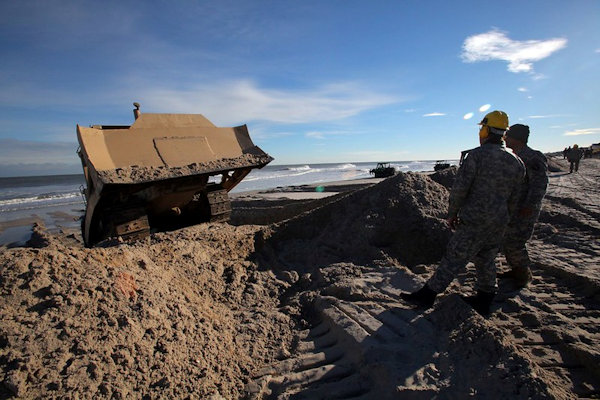SEJournal Online is the digital news magazine of the Society of Environmental Journalists. Learn more about SEJournal Online, including submission, subscription and advertising information.
 |
 |
| Bulldozers replenish the beach at Long Beach Island, New Jersey, in 2012. Photo: U.S. Air Force/Master Sgt. Mark C. Olsen via New Jersey National Guard Flickr (United States government work). |
TipSheet: Beach Nourishment Offers Challenging Local Environmental Stories
By Joseph A. Davis
Americans love beaches — when they can get to them. The caravans of cars that flock to the beaches in summer also support many beach towns that rely on tourist dollars.
But what if the beach disappears?
The Army Corps of Engineers has a fix for that: beach nourishment. It dredges and pumps sand from elsewhere (often the bottom offshore) and puts tons of it back on the shrinking beach. It’s fun to watch.
Yet what do the turtles and clams have to say?
The backstory
Land forms have changed over the millennia as seas have risen and fallen, since before humans arrived to watch. The natural movement of sand, from bars to dunes, is a science in itself.
In many places, water moves sand in currents, destroying and rebuilding beaches and barrier islands over natural cycles. It’s an endless story.
The first beach nourishment project
in the United States, that we know of,
was at Coney Island, New York, in 1923.
The first beach nourishment project in the United States, that we know of, was at Coney Island, New York, in 1923.
But sand mining and delivery have been going on in many other parts of the world for a long time. Not always for the better.
In some parts of the world, sand mining is run by organized crime, and the sand is used for things like construction.
Story ideas
Here are some questions to ask and angles to pursue for local beach-related building and rebuilding stories near you:
- Is there a beach nourishment project near you? How much does it cost and who is paying? How long is it taking? How many times has it been done? Who owns the beach? Who owns the land inland of the beach?
- What is the effect of your nourishment project on recreational beachgoers? Is the amount of sand limiting use of the beach? What other effects of crowding do you observe? Is the beach at capacity?
- What critters live at your beach — offshore, onshore or inland? Turtles? Mollusks? Shellfish? Shorebirds? Wading birds? How is the nourishment project affecting them? Is it burying them, their eggs, their habitat or their food sources?
- Is your beach related to a coastal wetland? How does the nourishment project affect the wetland? How does it affect water flow?
- Where does the sand for your project come from? What is in it? What kind of sand is it? What happens in the place it comes from?
- Are there natural dunes (and dune ecosystems) landward of your beach? Is beach erosion or nourishment changing them?
- Is the sand being borrowed from the nearby offshore? What’s happening to the sandbar? What’s happening to the surf? Ask the regular surfers whether the nourishment project affects the waves — and how. Ask surfers if they are amped.
- Why is the sand disappearing from the beach? What is the normal range of changes in beach extent without nourishment?
- Talk to ordinary beachgoers about what they think of the nourishment project. Ask kids. Ask boardwalk businesses.
- Talk to the natural resource managers (if any) overseeing the beach or nourishment project.
- How does the nourishment project affect navigation (e.g., inlets)? How does it affect other parts of the shoreline?
Reporting resources
- U.S. Army Corps of Engineers: It ends up doing (or contracting) many beach replenishment projects, especially those that are federally funded. Talk to your district office.
- State natural resources agencies: In some states, they sponsor or oversee beach nourishment projects.
- State coastal agencies: Nourishment projects in some states are overseen, under the federal Coastal Zone Management Act, by these state agencies. There are 34.
- American Shore and Beach Preservation Association: A group of scientists and engineers aimed at coastal conservation. Check your regional chapter.
- NOAA Office for Coastal Management: The federal arm that runs the Coastal Zone Management program.
- National Park Service Ocean and Coastal Parks: The NPS runs 88 really nice national seashores and similar units, where it does beach conservation. Many are on the Great Lakes.
- Surfrider Foundation: A membership-based group advocating for shoreline protection. Find your local chapter.
Joseph A. Davis is a freelance writer/editor in Washington, D.C. who has been writing about the environment since 1976. He writes SEJournal Online's TipSheet, Reporter's Toolbox and Issue Backgrounder, and curates SEJ's weekday news headlines service EJToday and @EJTodayNews. Davis also directs SEJ's Freedom of Information Project and writes the WatchDog opinion column.
* From the weekly news magazine SEJournal Online, Vol. 9, No. 30. Content from each new issue of SEJournal Online is available to the public via the SEJournal Online main page. Subscribe to the e-newsletter here. And see past issues of the SEJournal archived here.













 Advertisement
Advertisement 



